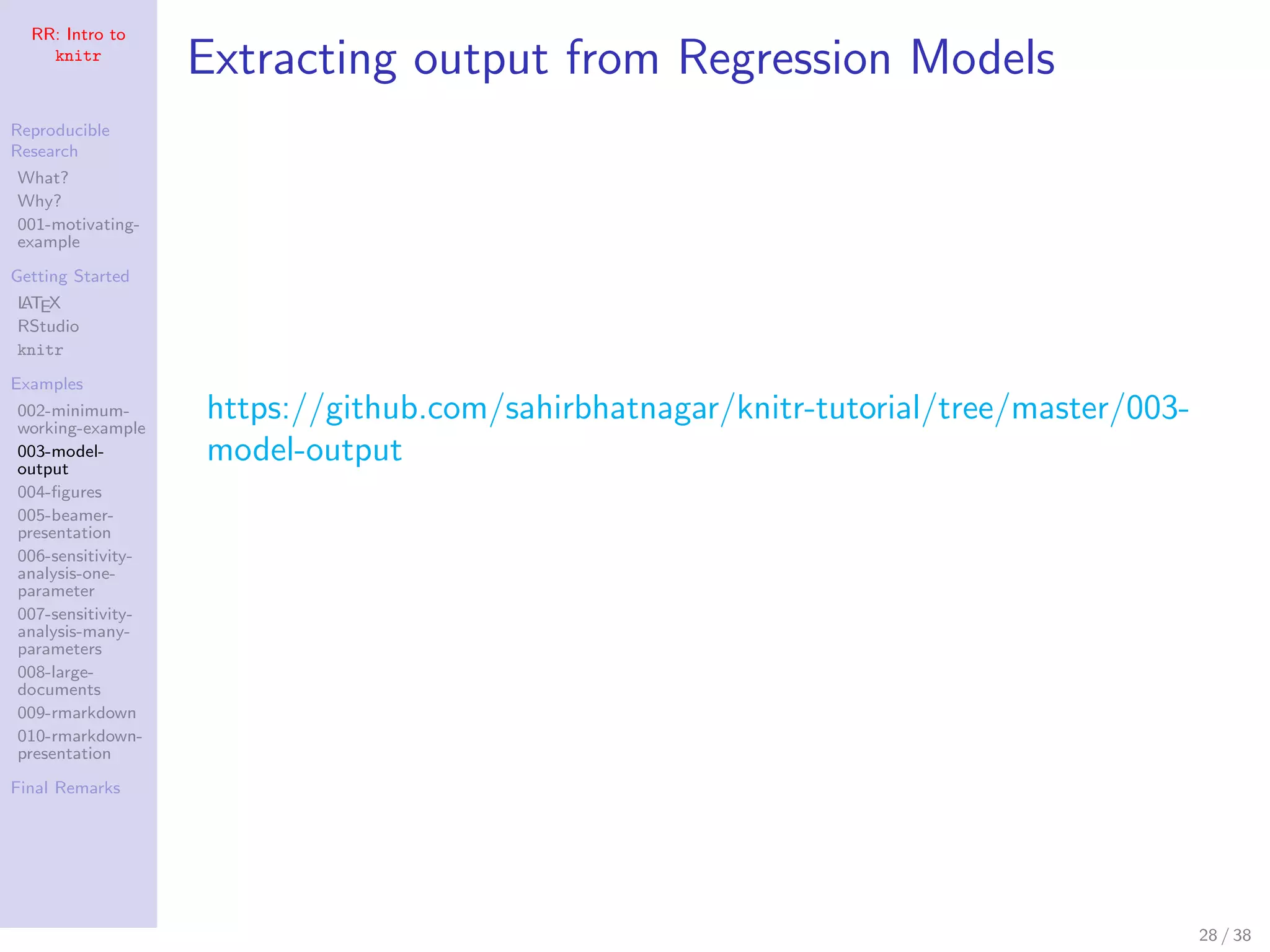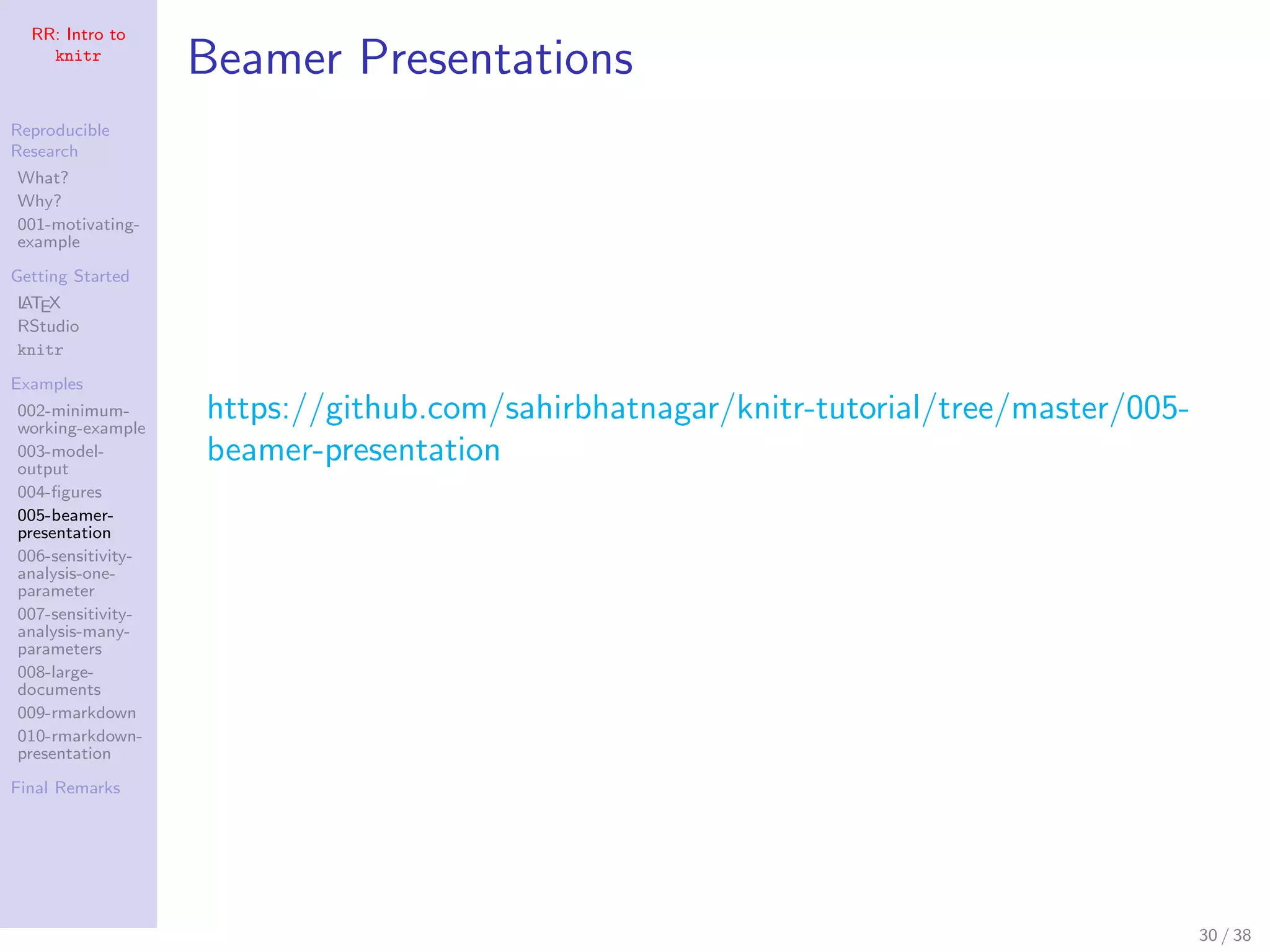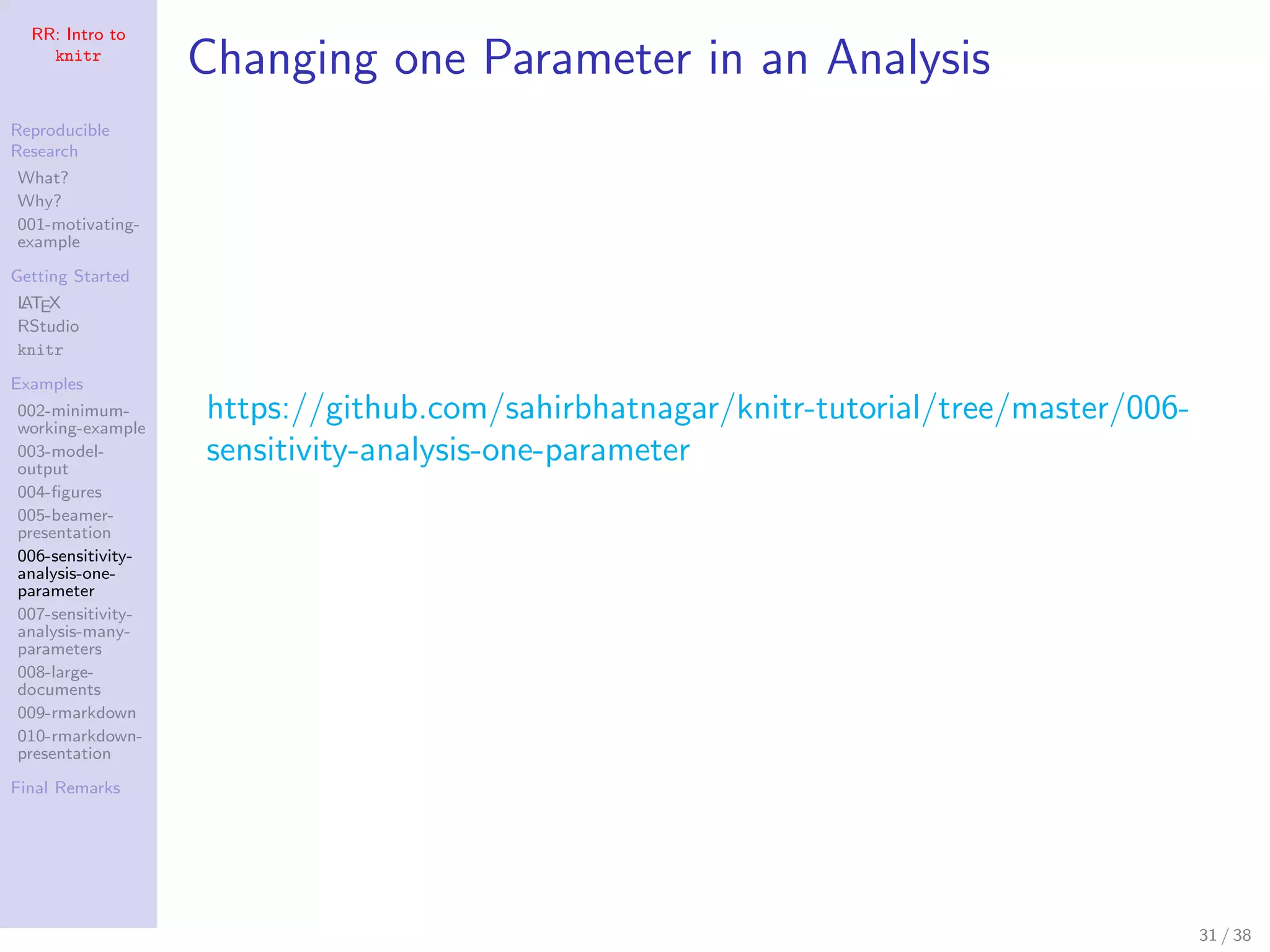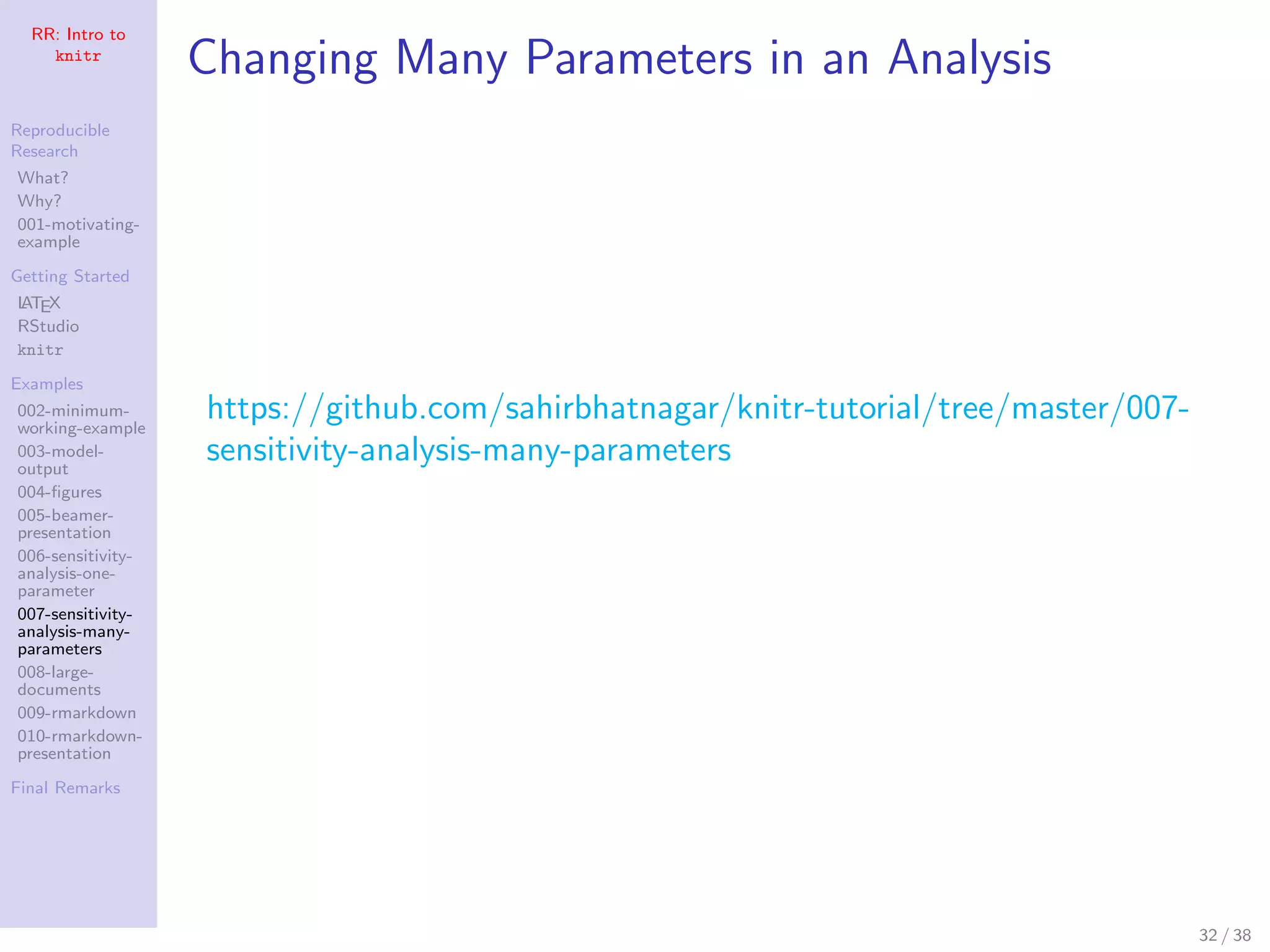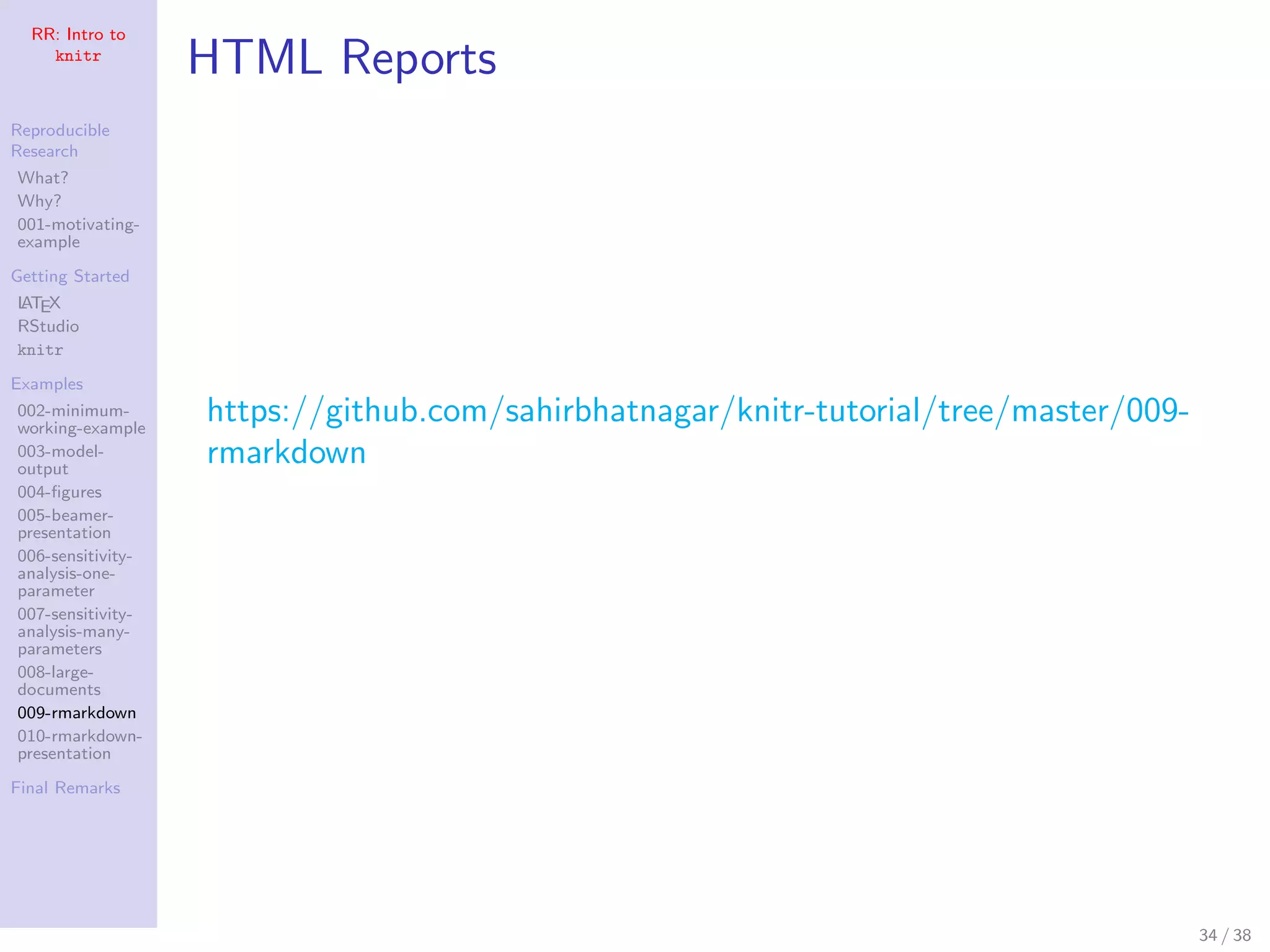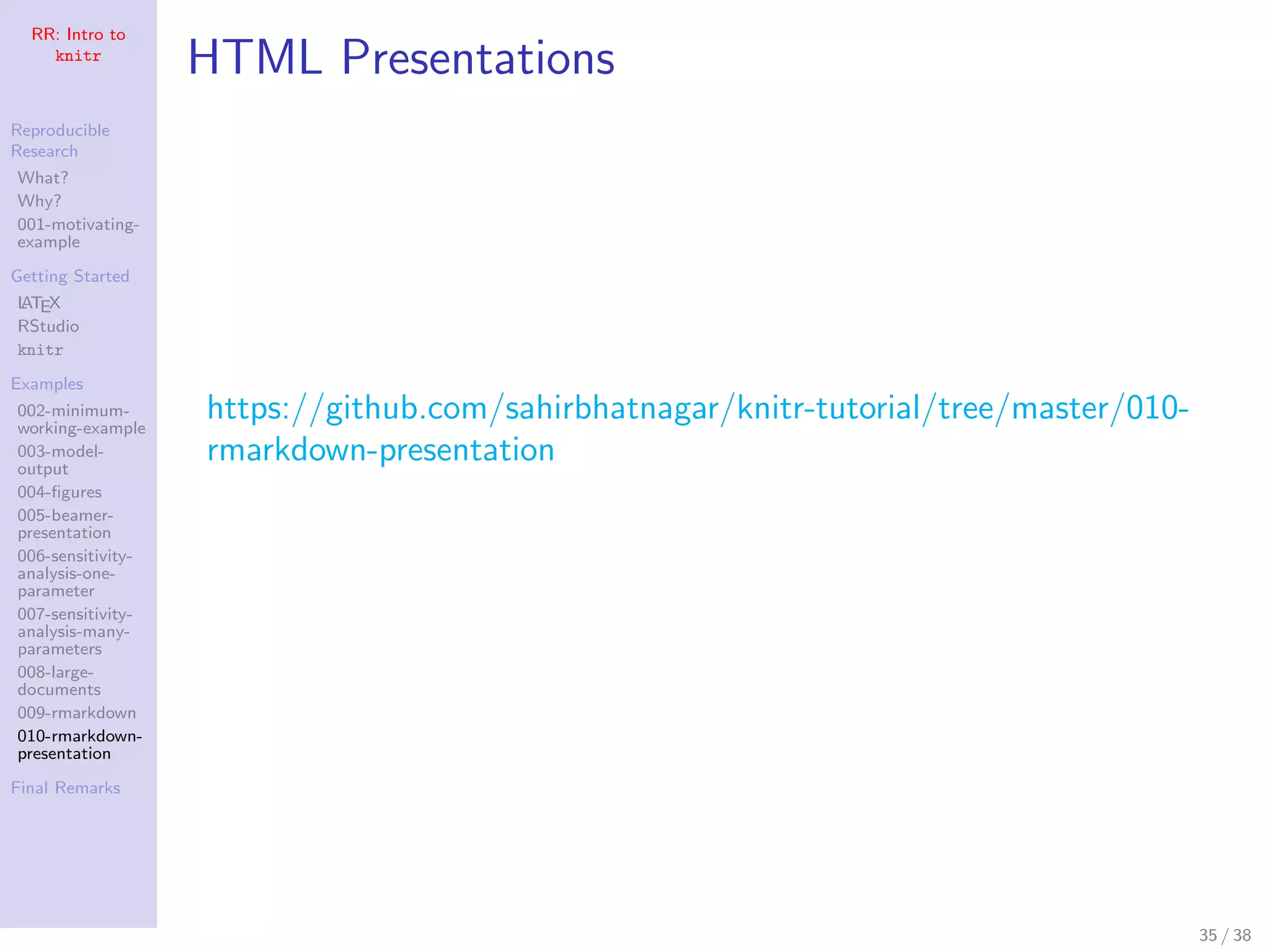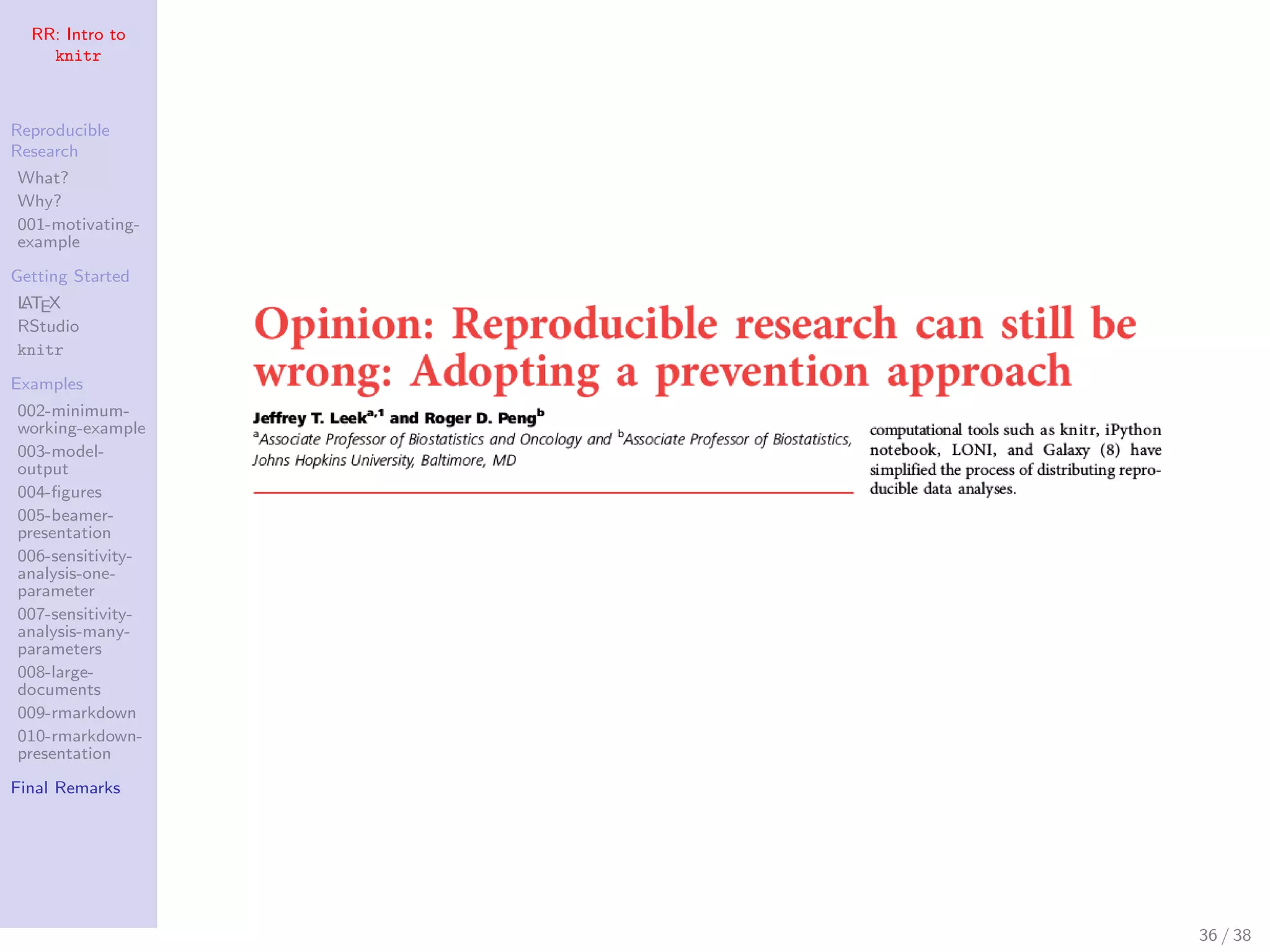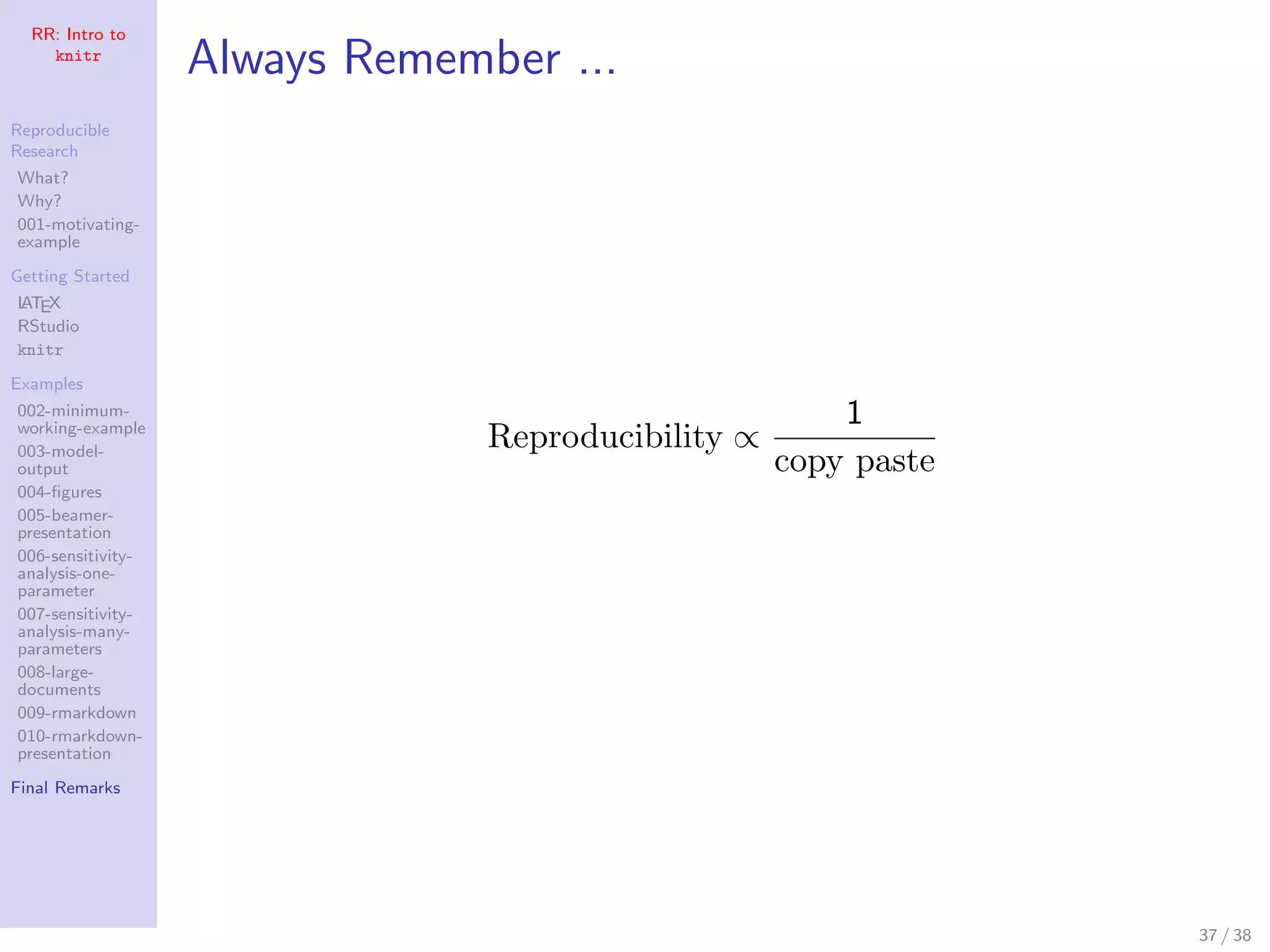The document is an introduction to reproducible research using the knitr package, explaining its significance in scientific work and detailing the tools involved, including R, LaTeX, and RStudio. It emphasizes the importance of sharing data and code for validation and replication of scientific findings. The presentation includes practical examples and guidelines for using knitr in creating dynamic documents.
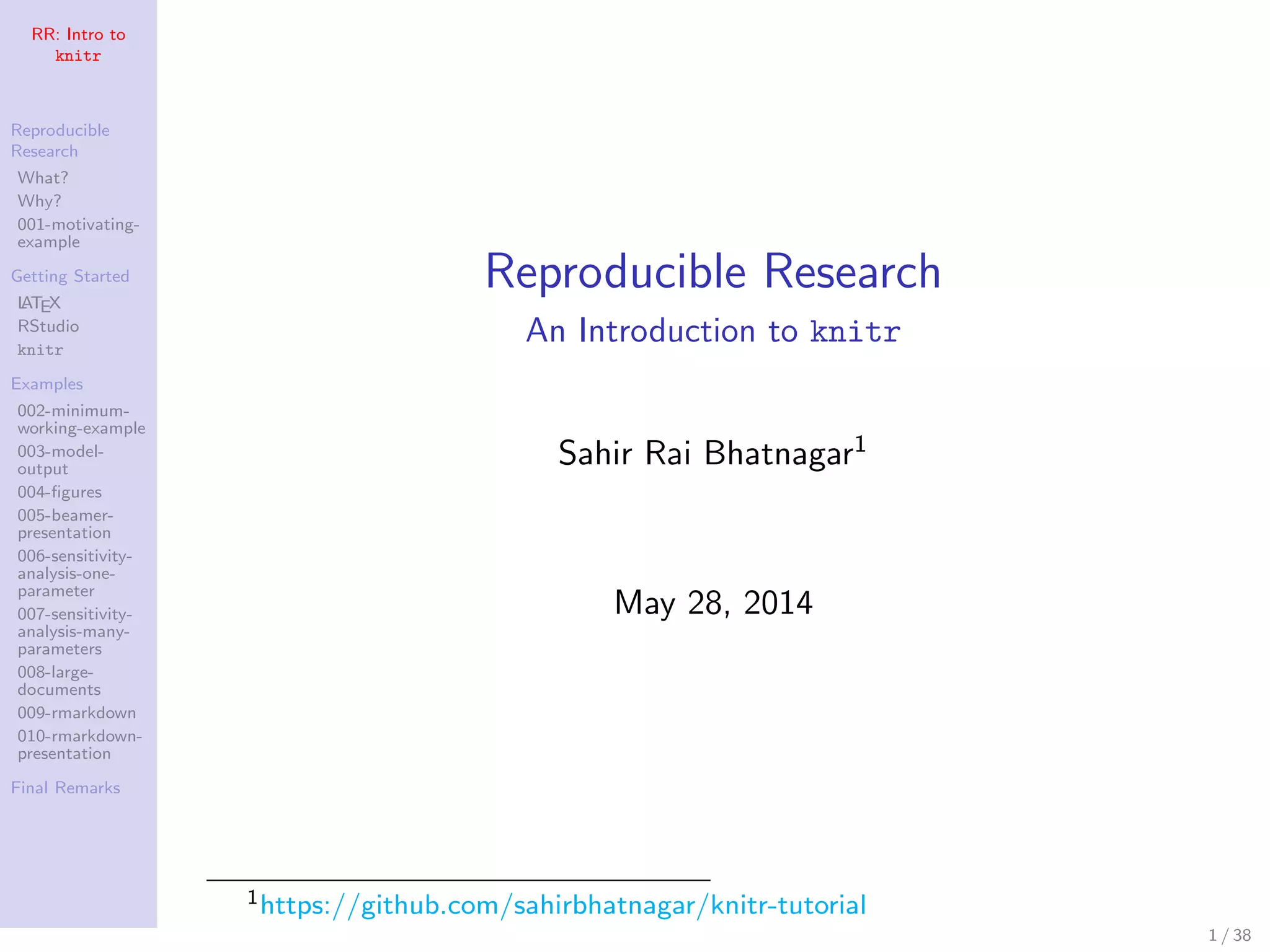



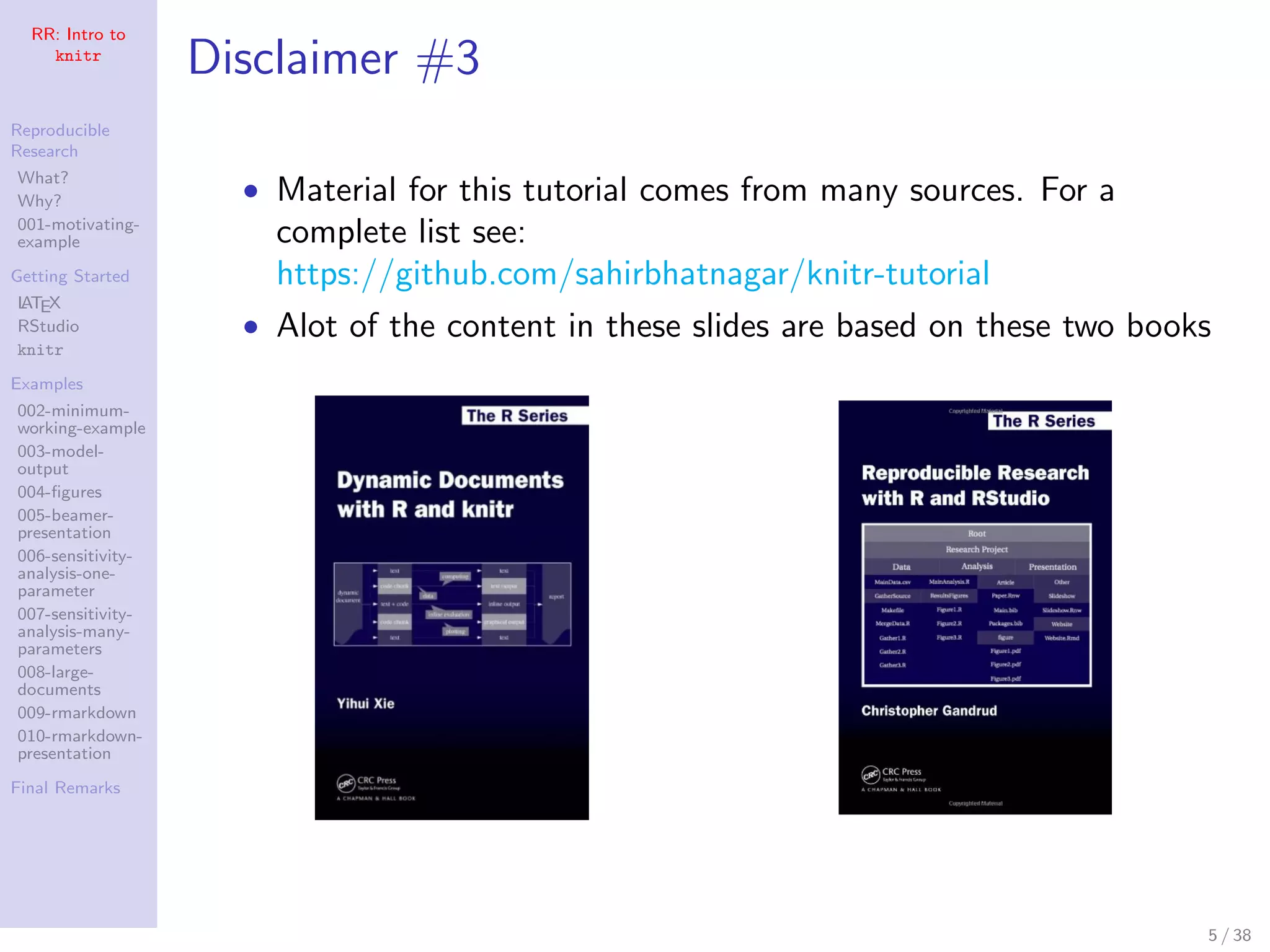
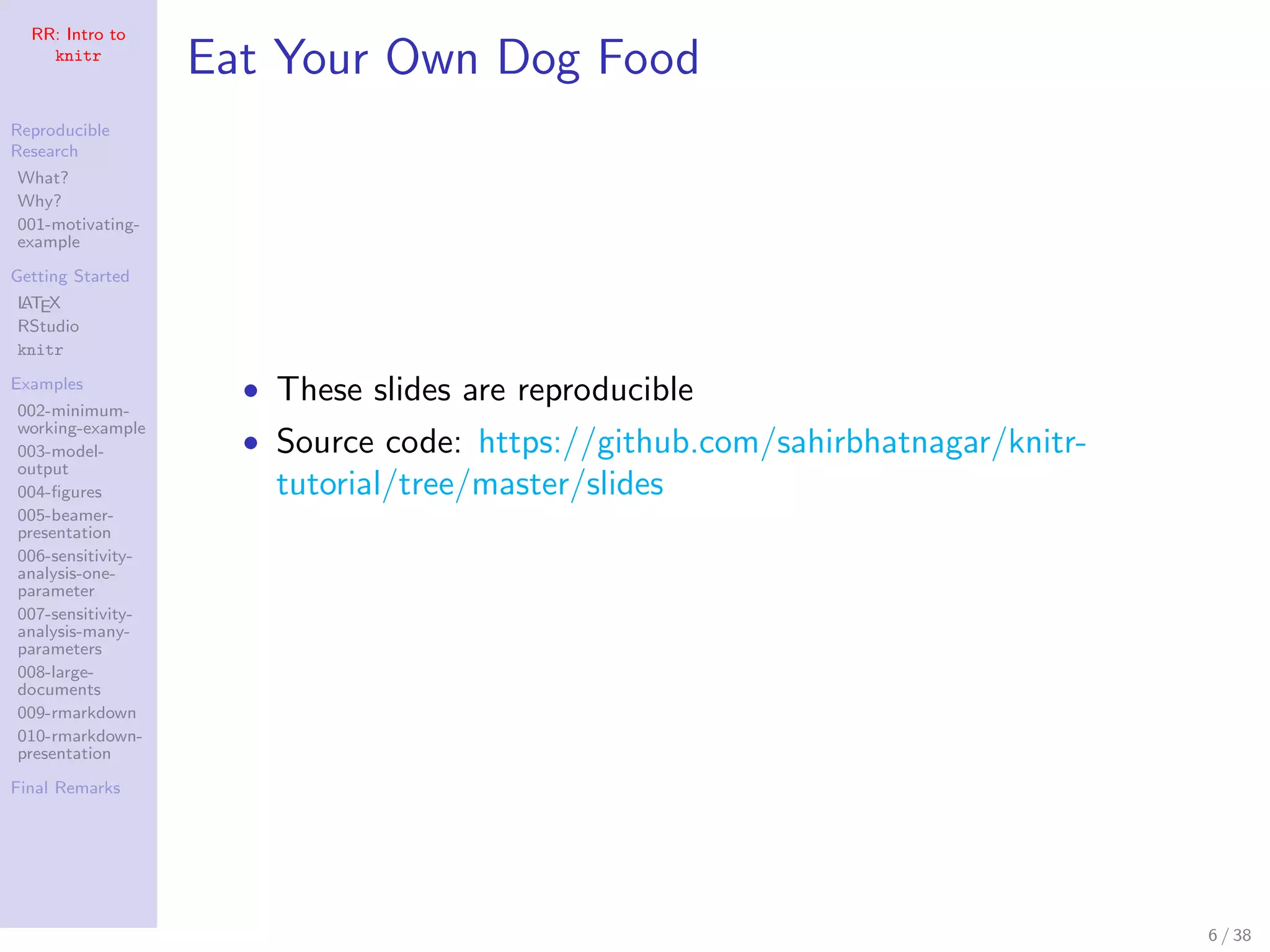

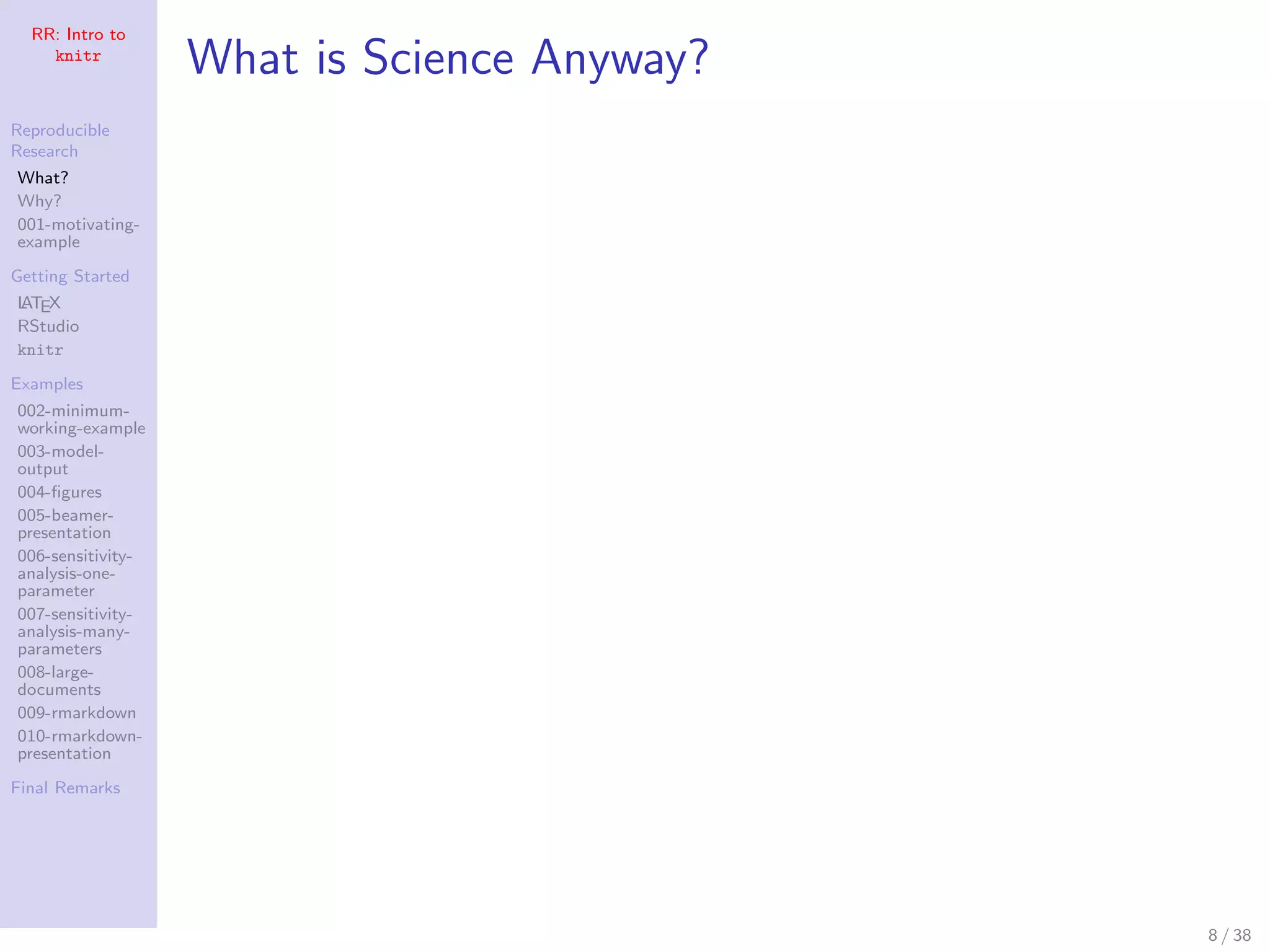

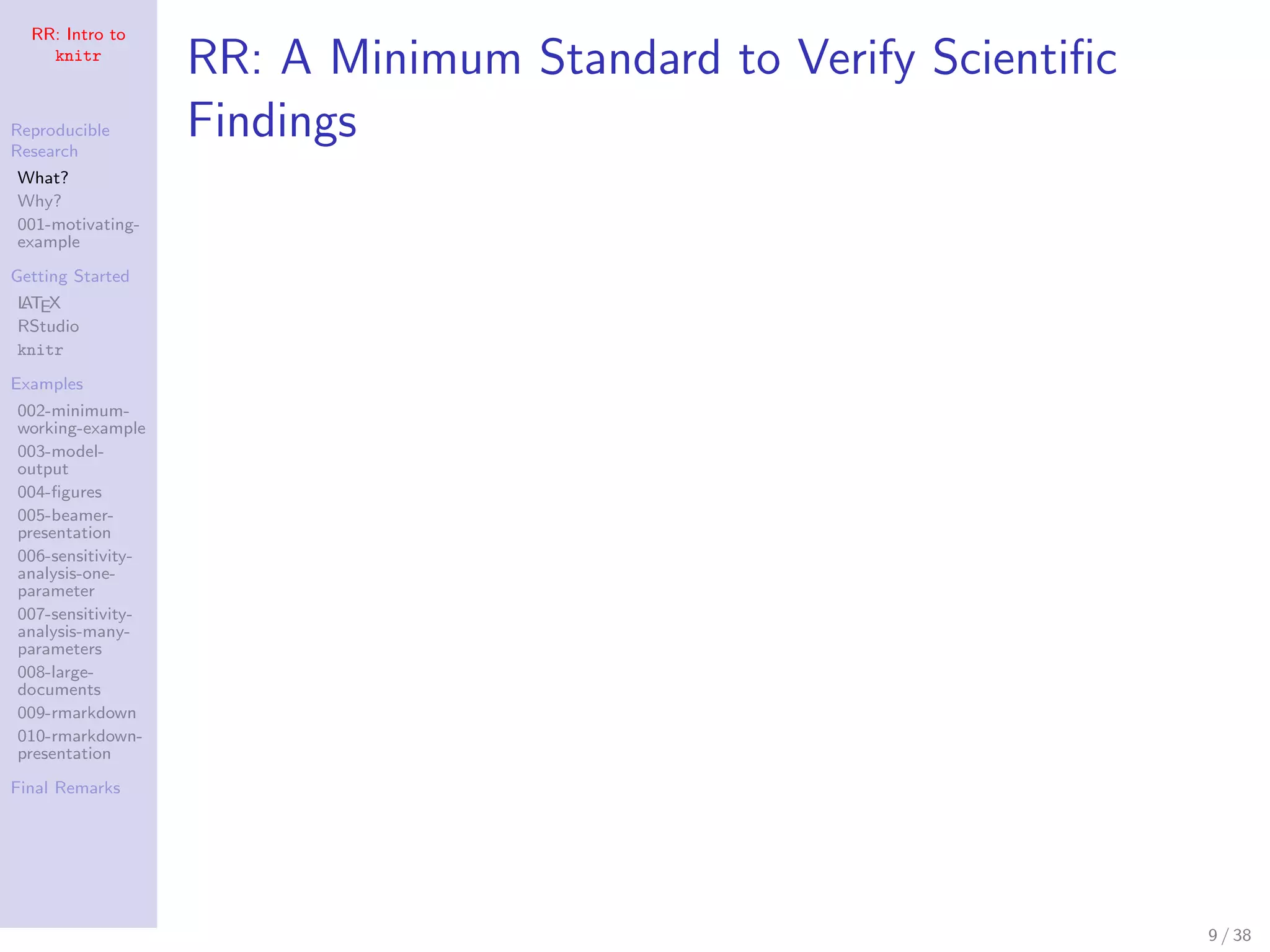



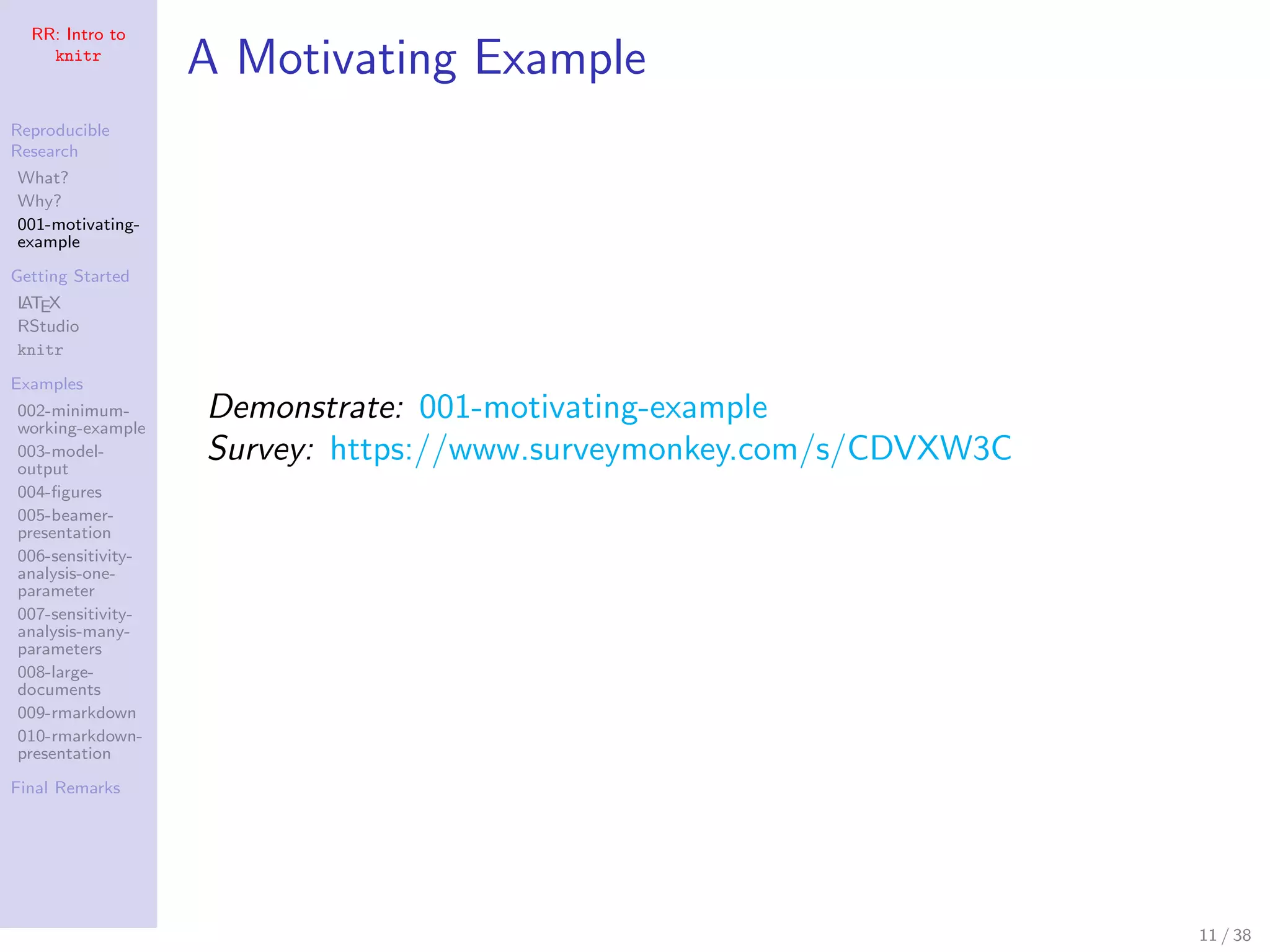
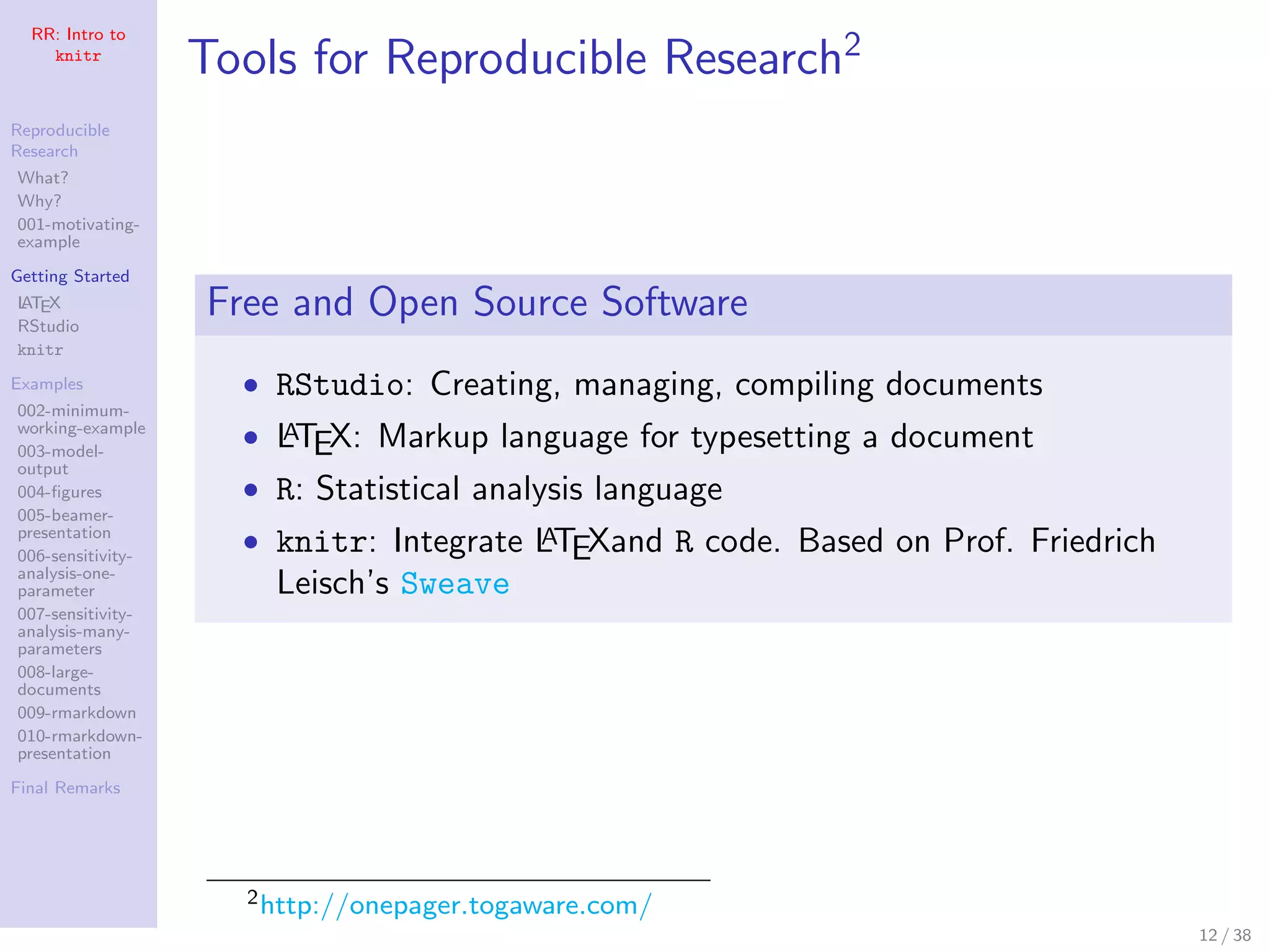
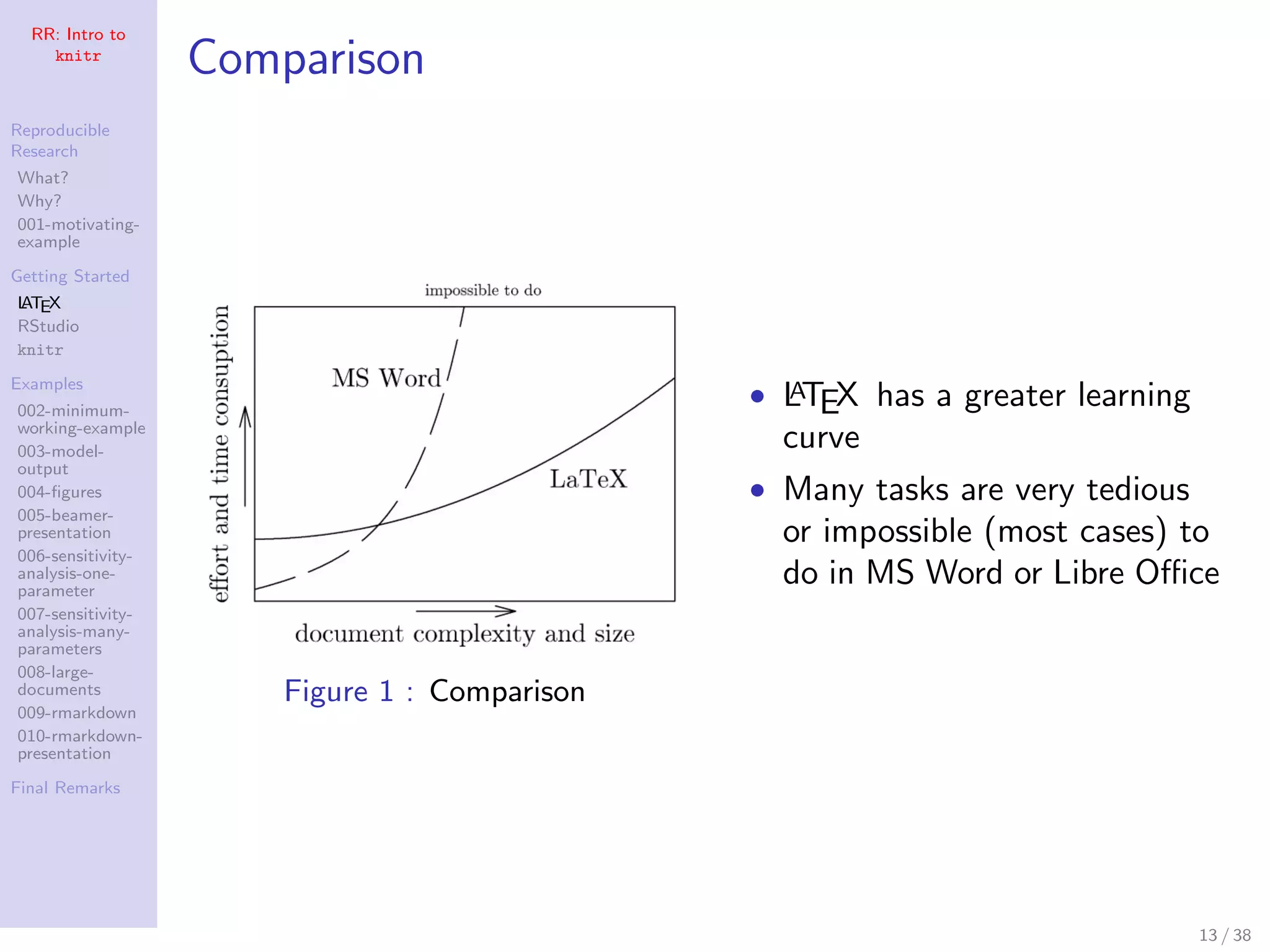


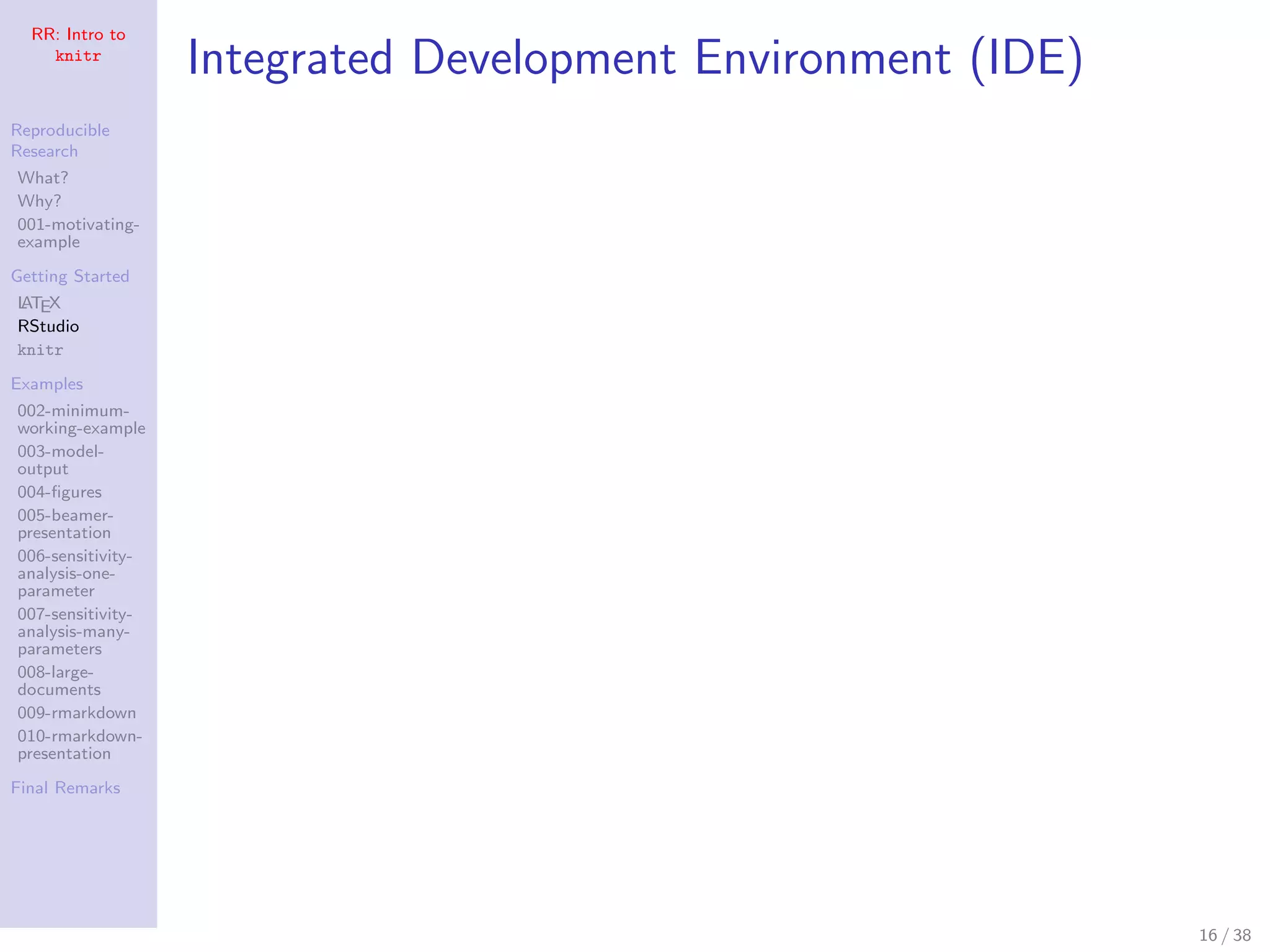
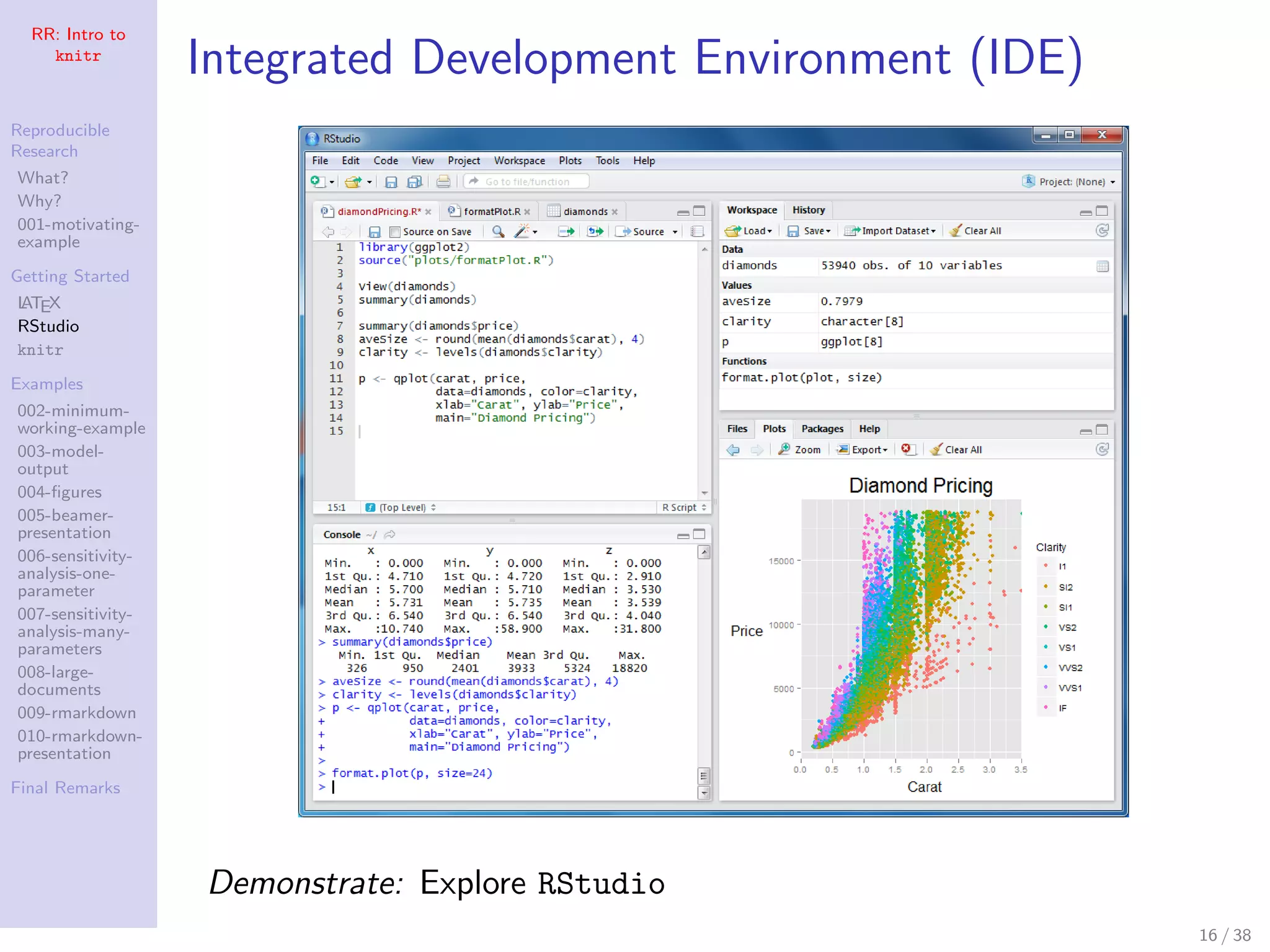
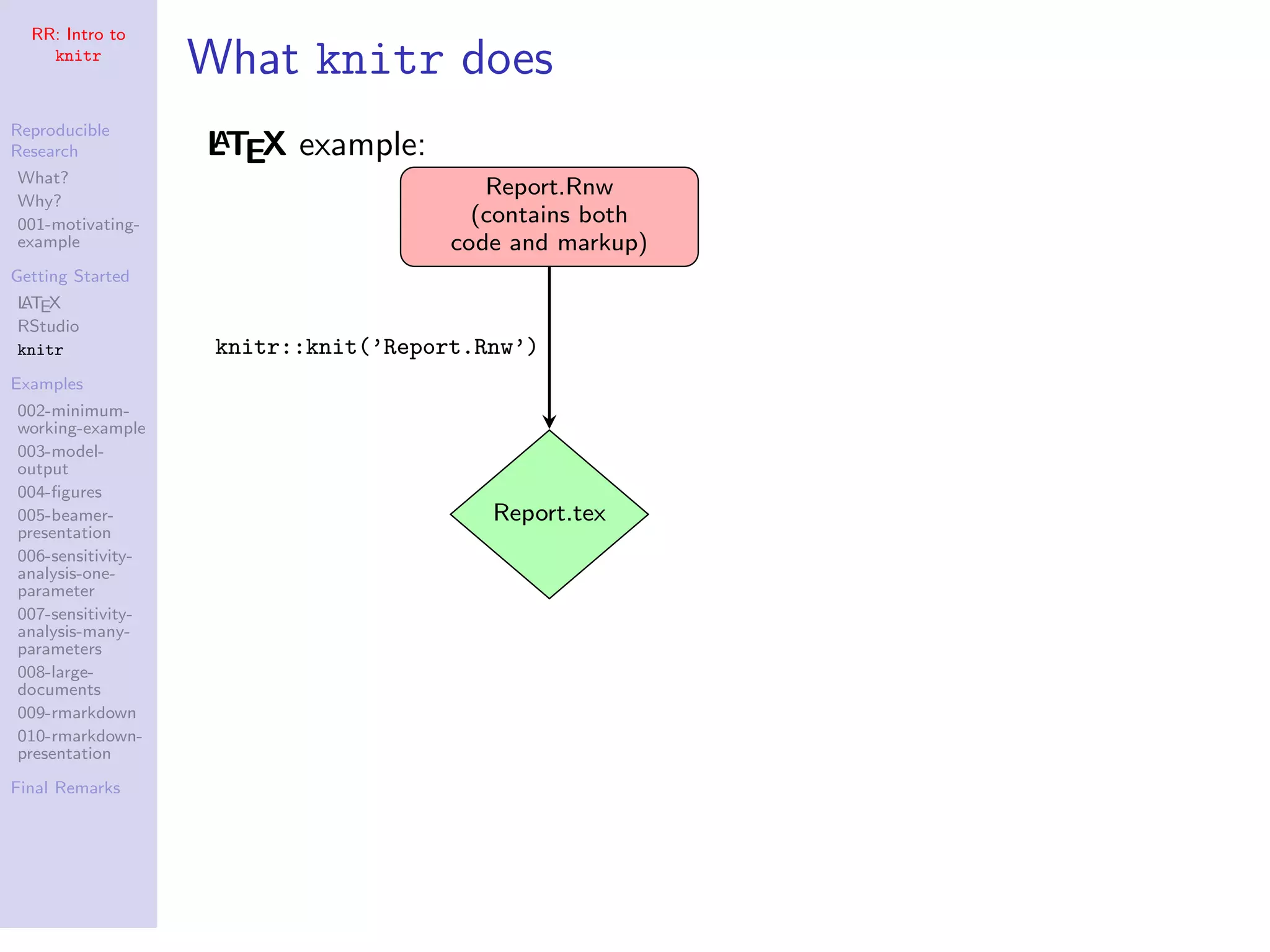



![RR: Intro to
knitr
Reproducible
Research
What?
Why?
001-motivating-
example
Getting Started
LATEX
RStudio
knitr
Examples
002-minimum-
working-example
003-model-
output
004-figures
005-beamer-
presentation
006-sensitivity-
analysis-one-
parameter
007-sensitivity-
analysis-many-
parameters
008-large-
documents
009-rmarkdown
010-rmarkdown-
presentation
Final Remarks
Example 1
<<example-code-chunk-name, echo=TRUE>>=
library(magrittr)
rnorm(50) %>% mean
@
produces
library(magrittr)
rnorm(50) %>% mean
## [1] 0.031
20 / 38](https://image.slidesharecdn.com/dpxj1gy6q8gbscjo0jvl-signature-b745e650c8fc9b39ffa3dc7065eeb2bb706ee8f21fcd813fa7ceff70299fe79f-poli-150610155926-lva1-app6892/75/Reproducible-Research-An-Introduction-to-knitr-25-2048.jpg)
![RR: Intro to
knitr
Reproducible
Research
What?
Why?
001-motivating-
example
Getting Started
LATEX
RStudio
knitr
Examples
002-minimum-
working-example
003-model-
output
004-figures
005-beamer-
presentation
006-sensitivity-
analysis-one-
parameter
007-sensitivity-
analysis-many-
parameters
008-large-
documents
009-rmarkdown
010-rmarkdown-
presentation
Final Remarks
Example 2
<<example-code-chunk-name2, echo=TRUE, tidy=TRUE>>=
for(i in 1:5){ (i+3) %>% print}
@
produces
for (i in 1:5) {
(i + 3) %>% print
}
## [1] 4
## [1] 5
## [1] 6
## [1] 7
## [1] 8
21 / 38](https://image.slidesharecdn.com/dpxj1gy6q8gbscjo0jvl-signature-b745e650c8fc9b39ffa3dc7065eeb2bb706ee8f21fcd813fa7ceff70299fe79f-poli-150610155926-lva1-app6892/75/Reproducible-Research-An-Introduction-to-knitr-26-2048.jpg)
![RR: Intro to
knitr
Reproducible
Research
What?
Why?
001-motivating-
example
Getting Started
LATEX
RStudio
knitr
Examples
002-minimum-
working-example
003-model-
output
004-figures
005-beamer-
presentation
006-sensitivity-
analysis-one-
parameter
007-sensitivity-
analysis-many-
parameters
008-large-
documents
009-rmarkdown
010-rmarkdown-
presentation
Final Remarks
Example 2.2
<<example-code-chunk-name3, echo=FALSE>>=
for(i in 1:5){ (i+3) %>% print}
@
produces
## [1] 4
## [1] 5
## [1] 6
## [1] 7
## [1] 8
22 / 38](https://image.slidesharecdn.com/dpxj1gy6q8gbscjo0jvl-signature-b745e650c8fc9b39ffa3dc7065eeb2bb706ee8f21fcd813fa7ceff70299fe79f-poli-150610155926-lva1-app6892/75/Reproducible-Research-An-Introduction-to-knitr-27-2048.jpg)
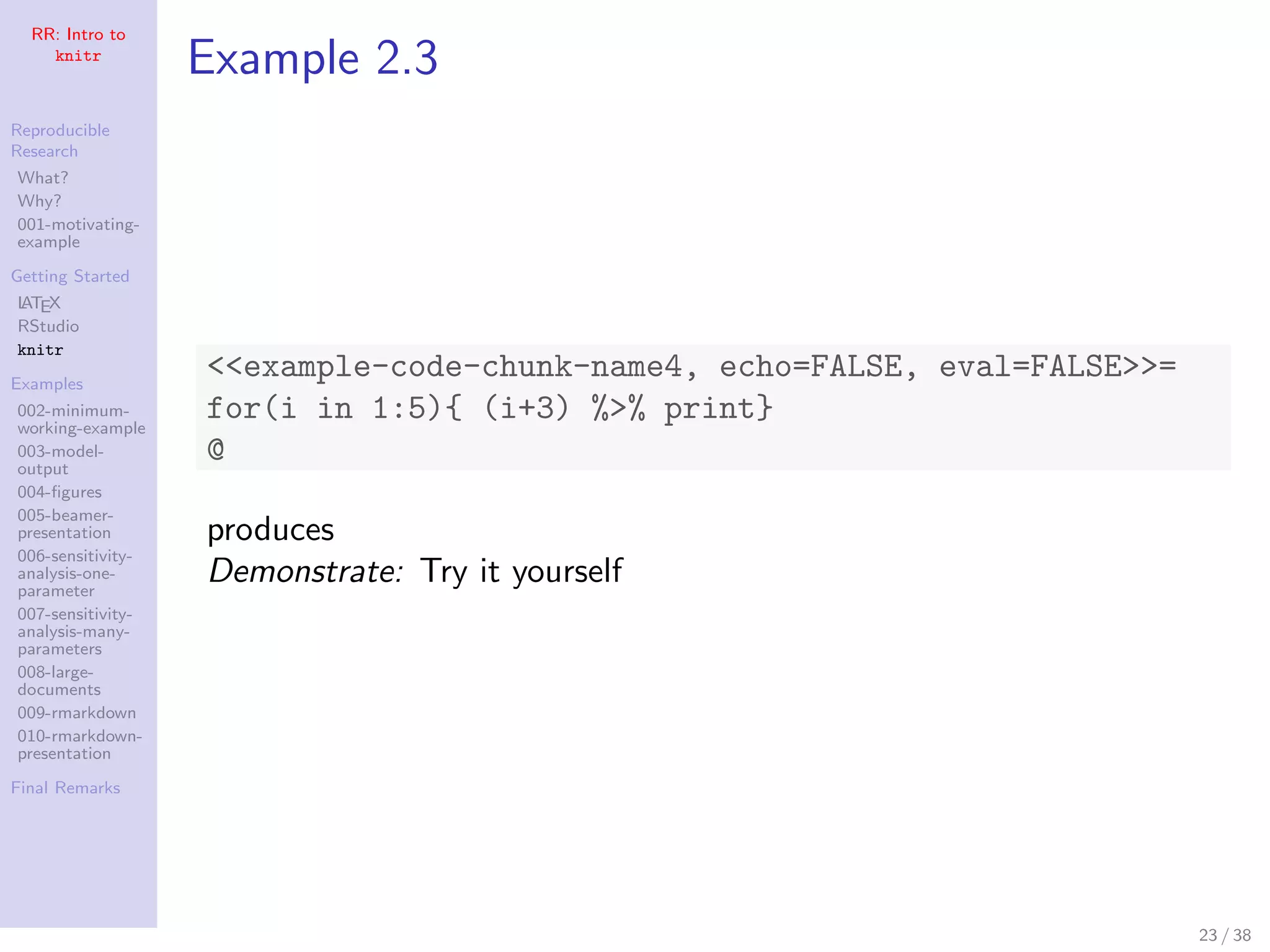
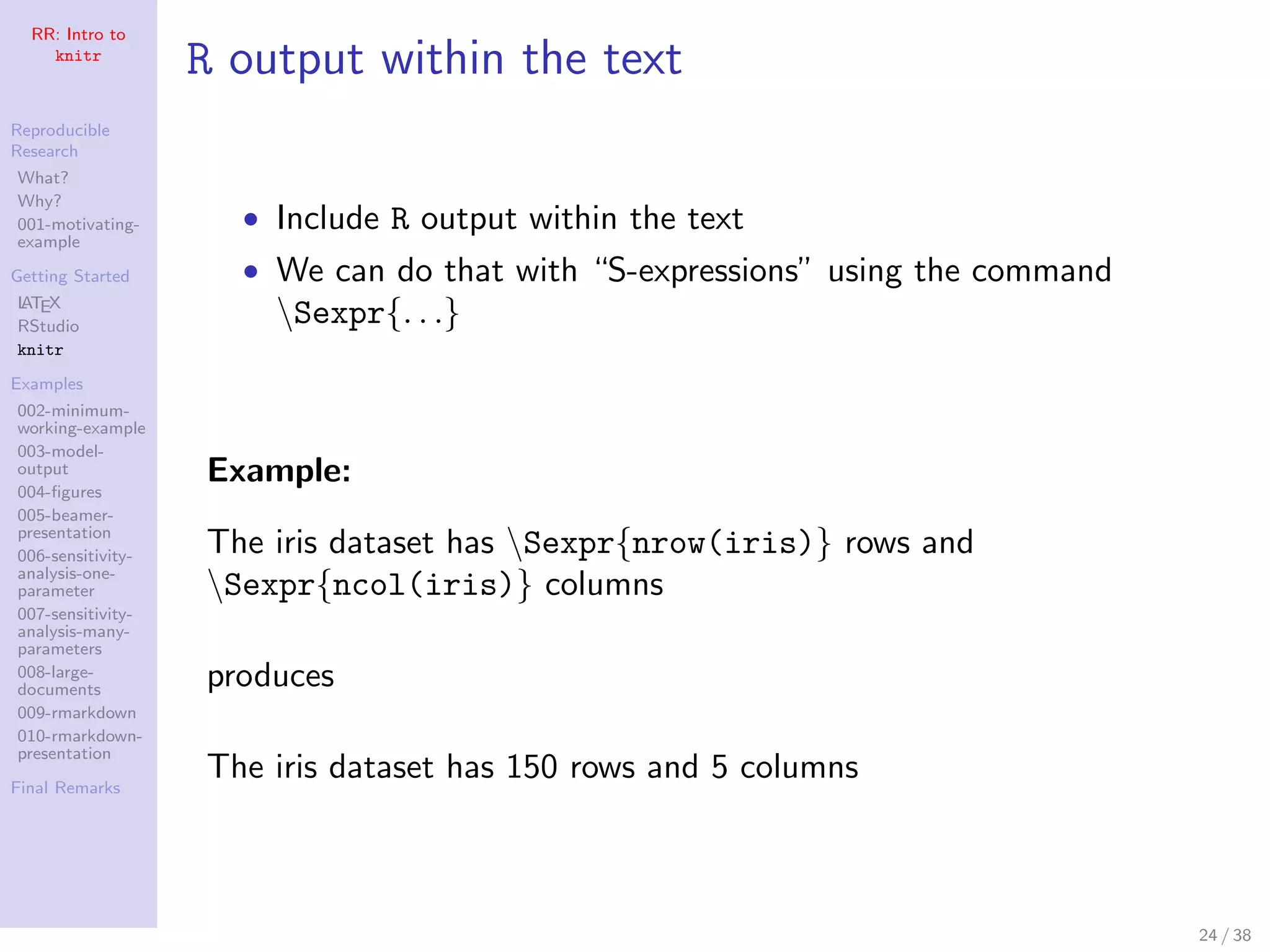
![RR: Intro to
knitr
Reproducible
Research
What?
Why?
001-motivating-
example
Getting Started
LATEX
RStudio
knitr
Examples
002-minimum-
working-example
003-model-
output
004-figures
005-beamer-
presentation
006-sensitivity-
analysis-one-
parameter
007-sensitivity-
analysis-many-
parameters
008-large-
documents
009-rmarkdown
010-rmarkdown-
presentation
Final Remarks
Include a Figure
<<fig.ex, fig.cap='Linear Regression',fig.height=3,fig.width=3>>=
plot(mtcars[ , c('disp','mpg')])
lm(mpg ~ disp , data = mtcars) %>%
abline(lwd=2)
@
100 200 300 400
1025
disp
mpg
Figure 4 : Linear regression
25 / 38](https://image.slidesharecdn.com/dpxj1gy6q8gbscjo0jvl-signature-b745e650c8fc9b39ffa3dc7065eeb2bb706ee8f21fcd813fa7ceff70299fe79f-poli-150610155926-lva1-app6892/75/Reproducible-Research-An-Introduction-to-knitr-30-2048.jpg)
![RR: Intro to
knitr
Reproducible
Research
What?
Why?
001-motivating-
example
Getting Started
LATEX
RStudio
knitr
Examples
002-minimum-
working-example
003-model-
output
004-figures
005-beamer-
presentation
006-sensitivity-
analysis-one-
parameter
007-sensitivity-
analysis-many-
parameters
008-large-
documents
009-rmarkdown
010-rmarkdown-
presentation
Final Remarks
Include a Table
<<table.ex, results='asis'>>=
library(xtable)
iris[1:5,1:5] %>%
xtable(caption='Sample of Iris data') %>%
print(include.rownames=FALSE)
@
Sepal.Length Sepal.Width Petal.Length Petal.Width Species
5.10 3.50 1.40 0.20 setosa
4.90 3.00 1.40 0.20 setosa
4.70 3.20 1.30 0.20 setosa
4.60 3.10 1.50 0.20 setosa
5.00 3.60 1.40 0.20 setosa
Table 1 : Sample of Iris data
26 / 38](https://image.slidesharecdn.com/dpxj1gy6q8gbscjo0jvl-signature-b745e650c8fc9b39ffa3dc7065eeb2bb706ee8f21fcd813fa7ceff70299fe79f-poli-150610155926-lva1-app6892/75/Reproducible-Research-An-Introduction-to-knitr-31-2048.jpg)

